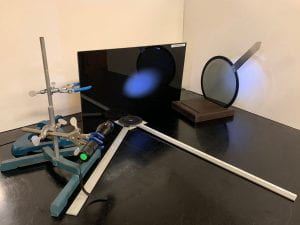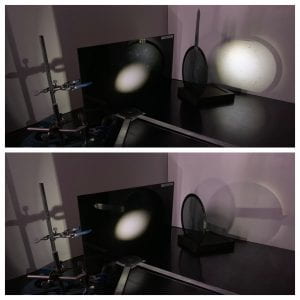This demo allows for the clear observation of polarized reflected light from Brewster’s angle.
Materials:
- Large flashlight [Cabinet H2]
- Black vinyl sheet and protractor [Cabinet E3]
- Large polarizer [Cabinet E3]
- 2 Base, rod, clamp, and rod-clamp assemblies
Setup/Demo:
Brewster’s law tells us that reflected light from a flat boundary can be 100% polarized when the angle between the reflected and refracted beams of light is 90°. The angle between the incident light and the normal of the boundary which leads to this polarization is Brewster’s angle.
Use the protractor to direct the flashlight towards the vinyl sheet at an angle of 57° with the normal. With the lights dimmed, the large polarizer should be placed in the path of the reflected light to verify that the light is polarized (Figure 2).
Explanation:
The Brewster’s angle can be observed when an incidence beam reflects off of a flat translucent boundary of a new refractive index at an angle specific to the boundary material. The refracted beam is polarized, as a result of the angle between the reflected and refracted beams being 90° (Figure 3).
Figure 3: Basic optical geometry of Brewster’s angle, from Wikimedia Commons.
The value of Brewster’s angle for any two translucent media of different refractive indices can be found using the mathematical representation of Brewster’s law, the derivation of which is shown below.
For the light to be polarized, the angle between the reflected and refracted rays must be 90°, so we can write:
To find Brewster’s angle, we need an expression that involves only the incidence angle and the different refractive indices, so it follows to introduce Snell’s law as it gives us the relationship between these variables.
We know that , so:
The cofunction identity is used to get the expression in terms of
and the refractive indices.
Isolating and equating it to Brewster’s angle allows us to write:
With this we can calculate the required angle for the demo since we know that the refractive index of vinyl is ≈ 1.531, and ≈ 1 for air.
This means we should expect an incidence angle of 57° for near complete polarization of the light in the demo.
Written by Aleksander Beck

